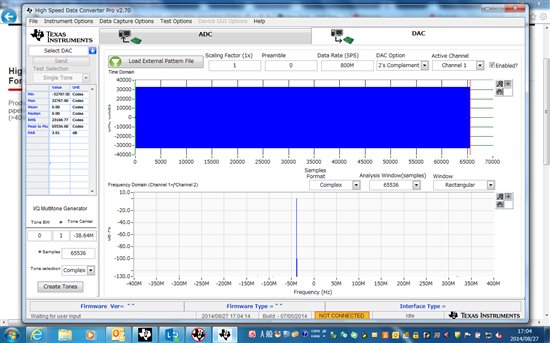Hello,
I would like to ask you how to set/configure GUI of DAC5688 and "High Speed Data Converter Pro" to output mixing 63.86MHz signal from 102.5MHz(NCO)+38.64MHz(DAC input).
The hardware conditions/settings are as below.
- 100MHz input to J20 connector of DAC5688EVM
- J17 connector is connected with J7 connector of TSW1400EVM via cable
- DAC5688 setting ---- PLL setting : x8, NCO setting : 102.5MHz(Set : 0x20CCCCC0=550292672)
- TSW1400 setting ---- DAC input : -38.64MHz (Complex), 800MHz sampling, 2's comp format, 65536 data length
Firmware : "DAC CMOS" down load
I could not get mixing 63.86MHz out from DAC5688 under these settings, got around 100-110MHz instead of 63.86MHz.
But in case of 100MHz Sampling data not 800MHz, I could get 63.86MHz.
Could you please advise me the reason why I could not succeed in case of 800MHz sampling?
I have attached GUI setting image and register setting file as below.
I would be very happy if you give some advice, thank you.
Best Regards,
Takumi
Texas Instruments Inc. DAC5688 EVM Register Configuration DAC5688 Registers Address Data 00 81 01 0B 02 03 03 00 04 19 05 10 06 00 07 00 08 C0 09 CC 0A CC 0B 20 0C A6 0D A6 0E 00 0F 2D 10 00 11 00 12 00 13 00 14 00 15 00 16 AA 17 10 18 80 19 00 1A 0D 1B FF 1C 00 1D 38 1E 39 CDCM7005 Registers Address Data 00 005FF1F0 01 02B282DD 02 D00000A2 03 00000027




